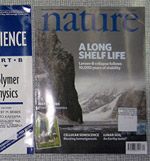Urban airports, a key refuge for insect conservation
 Invertebrates
Invertebrates If you have ever flown into New York City, you probably think of John F. Kennedy Airport as a bustling, chaotic place representative of the pace of life in the city it serves. For a diverse array of insect communities, however, JFK airport may be one of the last places in the metropolitan New York City area where they can call home.
As a new study in the Journal of Insect Conservation shows, the 305 hectares of semi-natural grasslands that cover much of the airport grounds provide habitat for a wide variety of arthropods. Lisa Kutschbach-Brohl and fellow researchers surveyed insects from 2003-2004 using a sweep net collector and vacuum sampler on four different grassland areas of the airport.
Over the two years, they collected a total of 8532 arthropods representing 5 taxonomic classes, 18 orders, and 125 families. Hemiptera, Orthoptera, and Diptera were the most common families which is consistent with surveys in natural and agricultural areas. Based on these results the authors write,
"Our results suggest the JFKIA airfield represents a large, semi-natural grassland area that has the ability to support diverse and dynamic populations of terrestrial arthropods, although the airfield is isolated from other semi-natural grassland habitats by marine and urban environments…These anthropogenically influenced grassland habitats are unique within this highly urbanized landscape which might serve as a refugium for grassland insects that require these habitats to persist. Consequently, such areas might have significant value for the conservation of terrestrial arthropods within urban areas."
Unfortunately, semi-natural grasslands are rare in New York City and most urban and suburban areas. In these places, turfgrass dominates open areas - whether it be lawns, office parks, or golf courses. The study results bolster the argument of those calling for more semi-natural areas in cities through habitat restoration in parks, the installation of green roofs, the use of native landscaping, etc.  Beatles at JFK Airport in New York.The study results also show that we need to better understand the biological value of existing semi-natural areas in cities and manage accordingly. In the case of JFK airport, the four grassland areas all had distinct vegetation communities, which the authors believe may have helped promote arthropod diversity. However, some management actions at the airport (e.g. mowing, applying pesticides) could have negative consequences for insects.
Beatles at JFK Airport in New York.The study results also show that we need to better understand the biological value of existing semi-natural areas in cities and manage accordingly. In the case of JFK airport, the four grassland areas all had distinct vegetation communities, which the authors believe may have helped promote arthropod diversity. However, some management actions at the airport (e.g. mowing, applying pesticides) could have negative consequences for insects.
--Reviewed by Rob Goldstein
Kutschbach-Brohl, L., Washburn, B., Bernhardt, G., Chipman, R., & Francoeur, L. (2010). Arthropods of a semi-natural grassland in an urban environment: the John F. Kennedy International Airport, New York Journal of Insect Conservation DOI: 10.1007/s10841-010-9264-8




Reader Comments